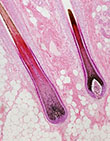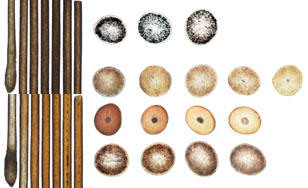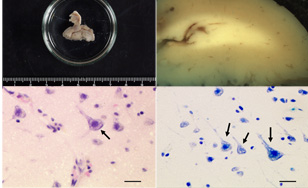In the National Research Institute of Police Science, morphological examination, blood typing, and DNA typing are carried out to determine whether hairs left on a crime scene come from the suspect (victim) or not. Among these three examinations, the first biology section is in charge of the morphological examination. After discriminating human hairs from animal hairs, human hairs are compared with the suspect's (victim's) hairs using features such as length, shaft form, color, continuity of medulla, and artificial treatments and the morphologic similarity between them is evaluated. As for animal hair, the type of animal is inferred from the morphological features, but a more reliable classification has yet to be established, and our current study focuses on classification and identification by DNA analysis.

The First Biology Section is responsible for research and casework concerning human body tissue such as hair, skin, and other soft tissues.
Forensic Hair Comparison

Microscopic images of hairs and cross-sections.undyed hair(upper), dyed hair(lower)
Forensic Tissue Identification

Microscopic images of brain samples.
shrunken pyramidal cell(arrow)
Soft tissue is collected at crime scenes as forensic evidence. Along with the routine analysis of forensic identification, histological examination is applied to these evidences to reveal the origin of human tissues. Histological alternations induced by various environmental factors such as decomposition and desiccation, often make it hard to apply the common method. Therefore some treatments must be applied to these evidences before common examination and we perform a study to develop examination methods that correspond to the state of each evidence.
